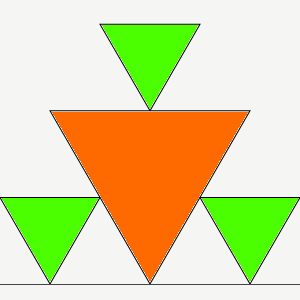Sierpiński triangles
27 Nov 2019
The Sierpinski triangle also called the Sierpinski sieve, is a fractal with the overall
shape of an equilateral triangle, subdivided recursively into smaller equilateral triangles.
This is one of the basic examples of self-similar sets–that is, it is a mathematically generated pattern
that is reproducible at any magnification or reduction. It is named after the Polish mathematician Wacław Sierpiński,
but appeared as a decorative pattern many centuries before the work of Sierpiński.
These triangles are drawn in much the same way many fractals are drawn. Using recursion.
 |
We start with the triangle depicted in orange on the image to the left. The frame is updated so that
we draw three triangles, half its size, adjoining it.
|
Javascript Demos ▼
Here's a bunch of javascript... things I wrote over the years whenever time permitted.
Abhivadaye Generator
Game of Life
Anagram Finder
Deflection Demo
Break Out
Cycloids
Double Pendulum
Flocking
Fog fly through
Fractals
EV Savings
Target Finder
Bouncing Spheres
Horizontal Stars
Image Scanning
Pandemic Simulator
JSON Beautify
Julia Sets
Kaleidoscope
Kock Fractals
Lorenz Attractor
Mandlebrot Set
Meta Balls
Number Convert
Number Game
Forces on Objects
Particles & Nodes
Simple Pendulum
Perlin Noise
Poisson Disk
QuadTree Search
8 Queens Problem
Natural Flocking
Ripples
Set Demonstration
Sine Waves
Classic Snake
Starfield
Sierpinski Triangles
Super Shapes 2D
Tic Tac Toe
Voronoi Diagram
Who Moved My...